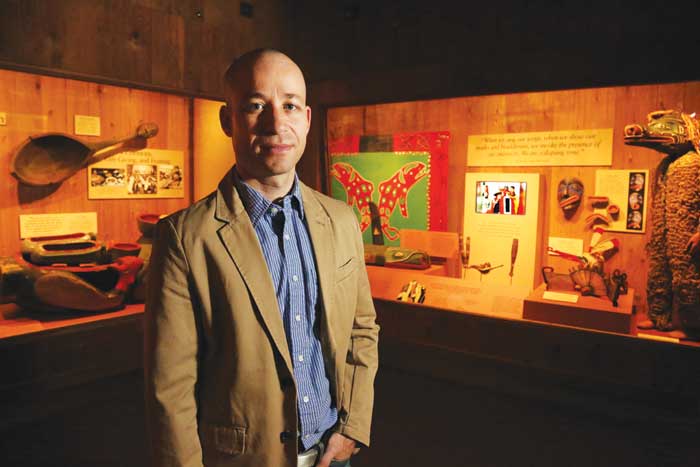
Dr. Chip Colwell-Chanthaphonh, curator of anthropology at the Denver Museum of Nature & Science (DMNS) stands in the Northwest Coast section of the Crane American Indian Hall. Behind him plays a video of the museum’s first repatriation under federal law, in 1997, of a sacred wooden hat belonging to the Tlingit of Alaska. The museum has returned more objects to the Tlingit than any other tribe. In the exhibit hall are many of the kinds of objects that the Tlingit use in their ceremonies.
Indiana Jones was mostly right when he recovered priceless artifacts from the baddies and declared, “These belong in a museum!”
The handsome movie archaeologist may have missed the mark on a few items of cultural significance, however. “Nine out of 10 archaeological objects do belong in museums, where we celebrate our past and our future,” said Dr. Chip Colwell-Chanthaphonh, curator of anthropology at the Denver Museum of Nature & Science (DMNS). “But certain cultural and sacred objects need to be returned to the cultures that created them—where they are most cherished. It comes down to respect for the values and views of other people and cultures.”
DMNS is a leader in the movement to return such artifacts to their homes, mostly to Native American tribes but also internationally. The museum has returned nearly 200 objects and 100 sets of human remains to their places of origin.
Cultural objects have been returned to the Hopi and Apache communities in Arizona, the Tlingit in Alaska, the Miccosukee in Florida and the Cheyenne and Arapahoe in Oklahoma. This February the museum repatriated 30 sacred statues, called vigango, to the Republic of Kenya.
“We work with the communities to return objects of cultural patrimony: communally owned items that are to them like our Liberty Bell—an object all the people have a right to, and not even the president has a right to sell,” said Colwell-Chanthaphonh, who has been at DMNS since 2007.
Colwell-Chanthaphonh and the museum work with Native American tribes to return found human remains. “It’s our ethical responsibility to consult with all potential kin,” he said. “This year we located 20 sets of human remains that we think are Native American, so we reached out to 566 federally recognized tribes to get their input—do they want us to return the remains, keep them for study, or share curatorship? We have a commitment to engage with the communities. They have a say in how their heritage is cared for.”
Such sensitivity for cultural rights wasn’t always the norm for museums. “Repatriation emerged in the 1970s,” said Colwell-Chanthaphonh. “Native American people coalesced around the return of their ancestors’ remains and objects that meant the cultural survival of their people. There were sit-ins at museums and archaeological digs and vigorous protest against colonial museum work.”
In 1990, the federal Native American Graves Protection and Repatriation Act (NAGPRA) was passed, requiring museums to inventory human remains and cultural items and consult with tribes about repatriation.
“There was animosity between the tribes and museums but we became collaborative. We sat around the same table and realized we had a lot in common,” said Colwell-Chanthaphonh. “In the collaborative process, some tribes want us to keep their objects because they don’t have a safe place for them. Others want us to do research on the human remains to better understand their ancestors’ lives. Museums learn that we don’t have a complete understanding of things. Tribal elders are able to correct our records with their stories and interpretations.”
Colwell-Chanthaphonh’s project to return the vigango sacred wooden statues to Kenya began in 2008. “I read an article about objects stolen from Kenya. I looked and sure enough, we had 30 of them,” he said. “It took five years to return them. The challenge was finding the right person to talk to. Who could help us? Last summer I read that Denver City Councilman Albus Brooks was going to Kenya with the Sister City Program. I cold-called him and a Kenyan delegate came the next week. The Sister City connection worked and we returned them to the National Museum in Nairobi, which will return them to their community of origin.”
The vigango were created by the Mijikenda on Kenya’s east coast. They are carved wooden statues between three and nine feet high that are erected as memorials to revered elders. They are believed to be living objects that intercede to bring good to the community.
More than 400 vigango are held in 21 museums in the U.S. and Europe. Although the Mijikenda strongly object to the removal of vigango, they continue to be stolen and sold on the international art market.
“There’s no legal instrument to recover stolen cultural objects. You continue to see antiquities for sale on eBay,” said Colwell-Chanthaphonh.
Although not legally bound to return the vigango, Colwell-Chanthaphonh and others felt it was important to return the communally owned, sacred items.
“The DMNS has done a lot to go beyond the letter of the law to embrace the spirit. Some other museums don’t return artifacts unless they are legally required,” he said.
Colwell-Chanthaphonh is conducting an ethnographic project to study whether the return of these objects and remains has led to the healing of the wounds of history.




0 Comments